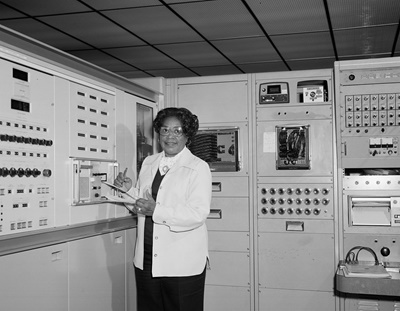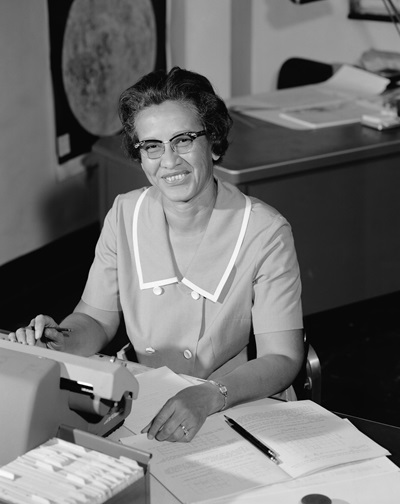If you’ve seen the 2016 film Hidden Figures, you know these women were American mathematicians whose work as National Aeronautics and Space Administration (NASA) employees were critical to the success of the first and subsequent U.S. crewed spaceflights. Check out the fun facts below about these mathematical legends!
Mary Jackson (April 9, 1921–February 11, 2005)

Mary Jackson, Source: NASA
Mary Jackson was an American mathematician and aerospace engineer at NACA/NASA. She worked atLangley Research Center in Hampton, Virginia for most of her career. She started as a computer at the segregated West Area Computing Unit in 1951 and took advanced engineering classes to become NASA's first black female engineer in 1958.
Fact - Jackson graduated with honors
Jackson grew up in Hampton, where she graduated from George P. Phenix Training School with the highest honors. After graduation, she taught mathematics, tutoring high school and college students, which she continued to do throughout her life.
Fact - Jackson worked as a computer
By 1943, she’d become a bookkeeper at the National Catholic Community Center. After the birth of her son, she became a clerk at the Office of the Chief Army Field Forces at Fort Monroe. In 1951, Jackson was recruited by National Advisory Committee for Aeronautics (NACA), which became NASA in 1958. She started as a research mathematician, or computer, at the Langley Research Center in her hometown.
Fact - Jackson's work was supersonic!
In 1953, she accepted an offer to work for engineer Kazimierz Czarnecki in the Supersonic Pressure Tunnel. The four foot by four foot, 60,000 horsepower wind tunnel was used to study forces on a model by generating winds at almost twice the speed of sound! Czarnecki encouraged Jackson to undergo training, so she could be promoted to an engineer title, but she needed to take graduate-level courses in mathematics and physics to qualify for the job.
Fact - She worked at the Theoretical Aerodynamics Branch of the Subsonic-Transonic Aerodynamics Division at Langley
Say that three times! Jackson had to petition the City of Hampton to allow her to attend the classes offered in a night program by the University of Virginia at the all-white Hampton High School. After completing the courses, she was promoted to aerospace engineer in 1958 and became NASA's first black female engineer. She analyzed data from wind tunnel experiments and real-world aircraft flight experiments at the Theoretical Aerodynamics Branch of the Subsonic-Transonic Aerodynamics Division at Langley to understand air flow, including thrust and drag forces, and improve the United States’ planes.
Fact - Jackson was a Girl Scout leader for more than 30 years!
That's a lot of daily good turns!
Katherine Coleman Johnson (August 26, 1918–February 24, 2020)

Katherine Johnson, Source: NASA
Katherine Johnson was an American mathematician with a 35-year career at NASA who earned a reputation for mastering complex manual calculations and helped pioneer the use of computers to perform those tasks. Upon her death, NASA Administrator James Bridenstine said, "Our NASA family is sad to learn the news that Katherine Johnson passed away this morning at 101 years old. She was an American hero and her pioneering legacy will never be forgotten."
Fact - Johnson's school didn't offer school past 8th grade
Johnson showed strong mathematical abilities from an early age. Since where she lived, Greenbrier County, West Virginia, did not offer public schooling for African-American students past the eighth grade, her family arranged for her to attend high school in Institute, on the campus of West Virginia State College (WVSC).
Fact - Johnson began high school when she was just 10 years old!
When she graduated at 14, she enrolled at West Virginia State and took every math course offered by the college. She graduated with summa cum laude honors in 1937 and began teaching.
Fact - A family member prompted her to apply to NACA
In 1939, Johnson was one of the first three black students and the first black woman admitted to the graduate school at West Virginia University. She left before finishing to start a family and returned to teaching once her daughters grew older. It wasn’t until 1952 at a family gathering that a relative mentioned to Johnson the NACA was hiring mathematicians. She accepted a job offer from the agency in June 1953.
Fact - Johnson work helped launch the Space Shuttle
Johnson's work included calculating trajectories, launch windows, and emergency return paths for Project Mercury spaceflights—including those for astronauts Alan Shepard, the first American in space, and John Glenn, the first American in orbit—and rendezvous paths for the Apollo lunar and command modules on flights to the Moon. Her calculations were also essential to the start of the Space Shuttle program. Johnson even worked on plans for a mission to Mars.
Fact - She received an award named after Snoopy!
In 2015, Johnson was awarded the Presidential Medal of Freedom by President Obama. In 2016, she was presented with the Silver Snoopy Award by NASA astronaut Leland D. Melvin as well as a NASA Group Achievement Award. In 2019, she was awarded the Congressional Gold Medal.
Dorothy Johnson Vaughan (September 20, 1910–November 10, 2008)

Dorothy Vaughan, far left. Source: NASA
Dorothy Vaughan was an American mathematician and human-computer who worked for NACA and NASA. In 1949, she became acting supervisor of the West Area Computing Unit, the first African-American woman to do so.
Fact - Vaughan was valedictorian
Vaughan graduated from Beechurst High School in 1925 as her class valedictorian. She then worked as a mathematics teacher at Robert Russa Moton High School in Farmville, Virginia to assist her family during the Great Depression. During her 14-year teaching career, Virginia's public schools and other facilities were racially segregated.
Fact - She began her career segregated, solving math calculations by hand
In 1943, Vaughan came to Langley Research Center during the height of World War II, thinking it would be a temporary job. She was assigned to the West Area Computing Unit, a segregated group of African-American women who solved complex mathematical calculations by hand. Due to prevailing Jim Crow laws, African Americans were required to work separately from their white counterparts, including the use of different dining and bathroom facilities.
Fact - Vaughan was acting as a team lead, years before her promotion
In 1949, Vaughan was promoted to be acting head of West Computing. She’d served for years in an acting role before being officially promoted. She was NACA’s first black supervisor and one of few female supervisors. Vaughan worked to gain opportunities for the women in West Computing as well as in other NACA departments.
Fact - She was stellar programer
Over her 28 years as a mathematician and programmer at Langley, Vaughan specialized in calculations for flight paths, the Scout Project, and computer programming. Seeing that machine computers could soon replace humans, she taught her female colleagues programming languages, like FORTRAN, and other concepts to prepare them for the transition. Vaughan retired in 1971.
Fact - Math and science is a family business!
One of her children later worked at NASA, too!
Fact - Vaughan's name is part of the moon!
In 2019, Vaughan was posthumously awarded the Congressional Gold Medal. The same year, Vaughan Crater, located on the far side of the Moon, was named in her honor.
Fact - "Mary," "Katherine," and "Dorothy" are all in space!
On November 6, 2020, satellites named after these three Americans were launched into space (ÑuSat 12 or "Dorothy," COSPAR 2020-079D, ÑuSat 17 or "Mary," COSPAR 2020-079J, ÑuSat 15 or "Katherine," COSPAR 2020-079G.
If you think these women were as amazing as we do and are interested in STEM, we have a variety of summer programs for you! Starting from as early as third grade with the National Youth Leadership Forum (NYLF): Pathways to STEM, extending through middle school to NYLF Explore STEM, and continuing into high school with NYLF Engineering, NYLF Medicine, Game and Technology Academy, and more, Envision by WorldStrides has an incredible STEM experience for everyone.
Sources:
https://en.wikipedia.org/wiki/Mary_Jackson_(engineer)
https://en.wikipedia.org/wiki/Katherine_Johnson
https://en.wikipedia.org/wiki/Dorothy_Vaughan
https://www.girlscouts.org/en/adults/volunteer.html
https://www.imdb.com/title/tt4846340/
https://www.nasa.gov/
https://www.nasa.gov/content/mary-jackson-biography
https://www.nasa.gov/feature/katherine-johnson-the-girl-who-loved-to-count
https://www.nasa.gov/directorates/heo/sfa/aac/silver-snoopy-award
https://www.nasa.gov/content/dorothy-vaughan-biography
https://www.nasa.gov/centers/langley/news/factsheets/Scout.html
background-image: a building with the American flag in front of it